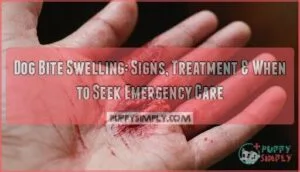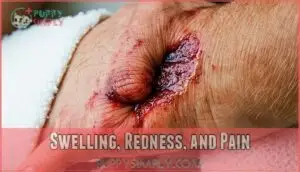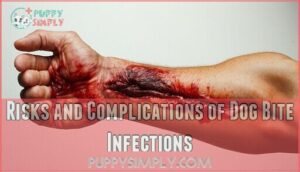This site is supported by our readers. We may earn a commission, at no cost to you, if you purchase through links.
 Dog bite swelling signals your body’s fighting an infection that’s more serious than it looks.
Dog bite swelling signals your body’s fighting an infection that’s more serious than it looks.
When a dog’s teeth puncture your skin, bacteria from their mouth gets trapped deep inside the wound. You’ll notice the swelling within 12-24 hours, often accompanied by warmth, redness, and throbbing pain.
Don’t brush it off as "just a bite"—dog mouths harbor dangerous bacteria like Pasteurella that can spread quickly through your bloodstream.
Clean the wound immediately with soap and water, apply antibiotic ointment, and watch for increasing swelling or red streaks.
The location of your bite matters more than you might think.
Table Of Contents
- Key Takeaways
- What Causes Dog Bite Infections?
- Symptoms of Dog Bite Infections
- Treatment for Dog Bite Infections
- Risks and Complications of Dog Bite Infections
- Specific Risks and Considerations for Hand and Foot Bites
- Symptoms and Treatment for Rabies and Tetanus
- Frequently Asked Questions (FAQs)
- How long should a dog bite be swollen?
- What does it mean when a dog bites you and it swells up?
- Is it normal for a dog puncture wound to swell?
- How do I know if a dog bite is serious?
- What should I do if I am bitten by a dog?
- Is there a risk of infection from a dog bite?
- How can I prevent infection from a dog bite?
- Are there any specific risks for hand and foot bites?
- Are there any long-term effects of a dog bite?
- How long does dog bite swelling last?
- Conclusion
Key Takeaways
- Don’t ignore swelling after a dog bite – it’s your body’s warning that dangerous bacteria like Pasteurella have entered deep into your wound and could spread to your bloodstream within 12-24 hours.
- Clean the wound immediately – wash thoroughly with soap and water, apply antibiotic ointment, and watch for red streaks or increasing swelling that signal a serious infection requiring medical attention.
- Seek emergency care for hand and foot bites – these areas have limited blood flow and higher infection risks, making them more likely to develop bone, joint, and tendon complications that can affect your mobility permanently.
- Get medical attention within 8 hours – you’ll need a proper wound assessment, possible antibiotics, and tetanus shots to prevent life-threatening complications like sepsis, which has a 40% mortality rate without treatment.
What Causes Dog Bite Infections?
Bacterial introduction occurs when a dog’s teeth pierce your skin, creating an open pathway for harmful microorganisms.
When those sharp canine teeth break through your skin, they’re basically rolling out the red carpet for dangerous bacteria to march right in.
A dog’s saliva composition contains various bacteria like staphylococcus and streptococcus that naturally live in their mouth.
Wound depth plays a vital role—deeper bites allow more bacteria to enter tissue layers.
Your immune response kicks in immediately, causing dog bite swelling as blood vessels dilate to fight infection.
The dog’s health status also matters, as sick animals may carry additional pathogens that increase infection risk.
Regular dog vaccinations are essential for preventing the spread of such pathogens.
Symptoms of Dog Bite Infections
You’ll notice infection symptoms within 24 to 48 hours after a dog bite breaks your skin.
Watch for redness, swelling, warmth, pain that gets worse, and any pus or fluid coming from the wound.
Swelling, Redness, and Pain
Your body’s alarm bells start ringing the moment a dog’s teeth break your skin.
Dog bite swelling appears within hours as your immune system floods the area with infection-fighting cells.
This natural response creates the classic trio of symptoms: swelling, redness, and pain around the wound.
Bite swelling causes include your body’s inflammatory response to bacteria and tissue damage.
The redness duration typically lasts 3-5 days for minor bites, while deeper wounds may stay inflamed longer.
Pain management starts with over-the-counter medications like ibuprofen, which also helps with inflammation control.
Watch for swelling complications like increasing warmth or spreading red streaks.
Consider purchasing ibuprofen products to manage pain and inflammation.
Natural remedies such as cold compresses can reduce initial swelling, but don’t rely on them alone.
Apply ice for 10-15 minutes every few hours during the first 24 hours.
The key is recognizing when normal healing crosses into infection territory.
Difficulty Moving The Affected Area
When dog bite swelling restricts your range of motion, it’s a red flag.
You might struggle to bend fingers, flex your wrist, or move the affected limb normally.
This limitation often signals nerve damage or muscle weakness developing beneath the surface.
Joint stiffness can worsen without proper inflammation control.
Don’t ignore these mobility issues—they may require rehabilitation exercises to prevent permanent function loss.
Drainage From The Wound
Pus or liquid oozing from your dog bite signals trouble. Infected dog bite drainage often appears yellow, green, or bloody with a foul odor.
Thick, cloudy wound discharge differs from normal clear fluid. Managing drainage requires gentle cleaning and sterile bandaging.
For specialized care, consider products aiding recovery. Monitor drainage amount and consistency daily.
Increasing wound infection discharge means you need medical attention immediately.
Treatment for Dog Bite Infections
When dealing with a dog bite infection, quick action makes all the difference. Start with thorough wound cleaning using soap and warm water to remove bacteria.
Apply antibiotic ointment and cover with sterile bandages for proper wound management. Your doctor might prescribe specific antibiotic choices like Augmentin to fight infection.
Don’t forget about tetanus shot requirements if you’re not current. While home remedies like cold compresses help with swelling, follow-up care with medical professionals guarantees proper infection prevention and monitors your healing progress effectively.
Dogs sometimes exhibit gentle nibbling behavior as a sign of affection, but bites that break the skin require medical attention.
Risks and Complications of Dog Bite Infections
Dog bite infections can spread beyond the wound site and cause serious health problems if you don’t get proper treatment.
You face risks like blood poisoning, nerve damage, and life-threatening bacterial infections that require immediate medical care, including the risk of nerve damage.
Spread of Infection to Other Parts of The Body
When bacteria from dog bites enter your bloodstream, infection spread becomes dangerous.
When dog bite bacteria invade your bloodstream, the infection becomes a life-threatening emergency.
These microorganisms travel through infection pathways, causing systemic infections like sepsis and cellulitis from bite wounds.
Your immune response may struggle against aggressive bacteria, leading to secondary infections in distant organs.
Osteomyelitis can develop when infection reaches bones, creating long-term effects requiring immediate medical intervention, which can be life-threatening.
Capnocytophaga Infection and Its Symptoms
Among the more serious complications you might face is Capnocytophaga infection, a rare bacteria found in dog saliva.
This infection poses heightened Immunocompromised Risks for people with weakened immune systems, alcoholism, or without a spleen.
Capnocytophaga Transmission occurs when bacteria enters through bite wounds, causing intense swelling, blistering, and dark skin discoloration within days.
Diagnosis Methods include blood tests and wound cultures.
You’ll notice Rare Symptoms like rapid fever progression and severe pain.
Treatment Duration typically requires antibiotics for 7-14 days, depending on infection severity.
Sepsis and Its Importance of Immediate Medical Attention
When infection from a dog bite spreads into your bloodstream, sepsis can develop within hours.
This life-threatening condition triggers rapid progression of symptoms including fever, confusion, and dangerously low blood pressure.
Sepsis symptoms demand immediate medical attention since mortality rates exceed 40% without treatment.
Doctors use intravenous antibiotics to fight bacteria and prevent permanent organ damage.
Changes in behavior can also indicate illness.
Don’t wait—sepsis prevention starts with seeking emergency care at the first warning signs.
Specific Risks and Considerations for Hand and Foot Bites
Dog bites to your hands and feet carry higher infection risks because these areas have less blood flow and more bacteria.
You’ll need immediate medical care since infections in these locations can spread quickly to bones, joints, and tendons.
Higher Risk of Infection
Your hands and feet face unique challenges in dog bite recovery.
These areas have limited blood flow, which means your body’s infection-fighting cells struggle to reach the wound quickly.
The close proximity to bones and joints creates perfect hiding spots for bacteria to multiply unchecked. Bacterial introduction happens faster in hand and foot bites because the skin is thinner and puncture wounds can reach deeper tissues.
If you’re immunocompromised or have diabetes, your infection risk jumps even higher. Bite location matters – wounds near joints or tendons are particularly vulnerable.
Wound depth plays a vital role too. Even small punctures can trap bacteria beneath the surface where antibiotics for bite treatment have difficulty penetrating.
Delayed treatment substantially increases your chances of developing an infected dog bite. Watch for dog bite symptoms like increasing pain, red streaking, or warmth.
Don’t wait – these areas need immediate medical attention to prevent serious complications.
Importance of Seeking Medical Attention
While hand and foot bites already pose elevated infection risks, getting prompt medical attention becomes absolutely non-negotiable. You can’t afford to wait and see what happens when dealing with these vulnerable areas.
Medical professionals perform thorough wound assessment to determine the bite’s severity and potential complications. They’ll clean the wound properly, evaluate your tetanus risk, and assess whether you need antibiotics to prevent infection. If the dog’s vaccination status is unknown, they’ll discuss rabies exposure protocols with you.
Here’s what medical evaluation covers:
- Nerve damage assessment – checking if the bite affected important nerves in your hands or feet
- Deep tissue examination – looking for signs of infection that aren’t visible on the surface
- Vaccination review – determining if you need tetanus shots or rabies prevention
Don’t gamble with dog bite swelling in these areas. Professional medical attention protects you from serious, long-term complications that could affect your mobility and quality of life.
Symptoms and Treatment for Rabies and Tetanus
Dog bites can expose you to serious diseases like rabies and tetanus, which require immediate medical attention to prevent life-threatening complications.
You’ll need specific vaccines and treatments based on the dog’s vaccination status and your own immunization history.
Rabies Symptoms and The Need for Post-exposure Vaccine
Within days of a dog bite, rabies incubation begins silently.
Early flulike symptoms progress to muscle spasms and jaw cramping.
Global rabies risk remains high, especially from unvaccinated dogs.
Post-exposure prophylaxis requires immediate action—the postexposure vaccine schedule includes four doses over fourteen days.
Don’t wait for symptoms; rabies variants are nearly 100% fatal once symptoms appear.
Tetanus Symptoms and The Need for Tetanus Vaccination
Tetanus poses another serious risk after dog bites.
This bacterial infection causes painful muscle spasms and lockjaw within days of wound exposure.
You’ll need a tetanus shot immediately if your last vaccination was over five years ago for dirty wounds, or ten years for clean ones.
Proper wound cleaning and following your booster schedule provides long-term protection against this dangerous disease.
Ensuring your pet has core vaccinations scheduled also protects them from preventable diseases.
Frequently Asked Questions (FAQs)
How long should a dog bite be swollen?
Swelling from your dog bite should improve within a few days to a week.
If it’s getting worse, spreading, or lasting beyond two weeks, you’ll need medical attention to check for infection.
What does it mean when a dog bites you and it swells up?
When a dog bite swells up, it’s your body’s natural inflammatory response to trauma and potential bacterial contamination.
The swelling indicates your immune system is fighting possible infection from bacteria introduced through the wound, which is your body’s natural defense mechanism, involving an immune response.
Is it normal for a dog puncture wound to swell?
Better safe than sorry – yes, it’s completely normal for puncture wounds to swell.
Your body’s inflammatory response kicks in, sending fluid to the injury site to fight potential infection and begin healing.
How do I know if a dog bite is serious?
Watch for deep puncture wounds, heavy bleeding, or signs of infection like pus, increasing pain, and fever.
You’ll need immediate medical attention if there’s nerve damage, broken bones, or difficulty moving, which can be indicated by increasing pain and other severe symptoms.
What should I do if I am bitten by a dog?
Like a broken dam releasing water, your body’s immediate response matters most.
Clean the wound thoroughly with soap and water, apply pressure to stop bleeding, cover with bandages, and seek medical attention within eight hours.
Is there a risk of infection from a dog bite?
Yes, there’s significant infection risk from dog bites.
About 50% introduce harmful bacteria like staphylococcus and streptococcus.
You’ll need immediate cleaning, possible antibiotics, and medical attention within eight hours to prevent serious complications.
How can I prevent infection from a dog bite?
Clean the wound immediately with mild soap and warm water for 5-10 minutes.
Apply antibiotic cream and cover with sterile bandage.
Seek medical attention within 8 hours for antibiotics or tetanus shot.
Are there any specific risks for hand and foot bites?
Hand and foot bites are ticking time bombs—they’re infection hotspots due to limited blood flow and tight spaces.
You’ll face higher risks of deep tissue damage, nerve injury, and bone infections that resist treatment, which are infection hotspots.
Are there any long-term effects of a dog bite?
Dog bites can leave lasting impacts beyond initial healing.
You might experience chronic pain, nerve damage, reduced mobility, persistent numbness, or psychological trauma.
Scarring and recurring infections are also possible long-term complications requiring ongoing medical attention, which can lead to lasting impacts.
How long does dog bite swelling last?
Coincidentally, swelling duration varies based on bite severity and your body’s response.
You’ll typically see improvement within days to weeks.
Mild cases resolve in 24-48 hours, while deeper wounds may swell for several weeks or longer, which is related to the overall body’s response.
Conclusion
Remember, dog bite swelling isn’t just cosmetic—it’s your body’s alarm system screaming that bacteria have invaded.
You can’t afford to ignore the warning signs of redness, warmth, or spreading infection.
Clean wounds immediately, monitor symptoms closely, and don’t hesitate to seek medical care when swelling worsens.
Hand and foot bites demand extra attention due to infection risks.
Your quick response makes the difference between simple treatment and serious complications requiring emergency intervention.
- https://www.who.int/news-room/fact-sheets/detail/animal-bites
- https://www.assh.org/handcare/condition/animal-bite-dog-bite-cat-bite
- https://www.cdc.gov/healthy-pets/about/dogs.html
- https://www.petful.com/behaviors/warning-signs-that-dog-may-bite/
- https://my.clevelandclinic.org/staff/9024-stephen-sayles-iii












